Propanediol (and) Caprylic Acid (and) Xylitol as a New Single Topical Active Ingredient against Acne: In Vitro and In Vivo Efficacy Assays
Abstract
:1. Introduction
2. Results and Discussion
2.1. MIC
2.2. Time-Kill Test
2.3. 5-Alpha Reductase Gene Expression
2.4. Clinical Trials (Sebumetry, Porphyrins, Inflammatory Lesions, Face Skin’s General Aspect/Appearance and Perceived Efficacy by Dermatologist)
3. Material and Methods
3.1. Minimum Inhibitory Concentration (MIC)
3.2. Time-Kill Test
3.3. Evaluation of 5-Alpha Reductase Gene Expression
3.4. Clinical Trials
3.4.1. Participants and Application Protocol of the Samples
3.4.2. Sebumetry Measurement
3.4.3. Porphyrins, Inflammatory Lesions and Face Skin’s General Aspect/Appearance
3.4.4. Perceived Efficacy by Dermatologist
4. Conclusions
Author Contributions
Funding
Institutional Review Board Statement
Informed Consent Statement
Data Availability Statement
Acknowledgments
Conflicts of Interest
Sample Availability
References
- Brenner, F.M.; Rosas, F.M.B.; Gadens, G.A.; Sulzbach, M.L.; Carvalho, V.G.; Tamashiro, V. Acne: Um Tratamento Para Cada Paciente. Rev. Ciênc. Méd. 2006, 15, 257–266. [Google Scholar]
- Harris, M.I. Pele-Do Nascimento à Maturidade; Senac São Paulo: São Paulo, SP, Brazil, 2016; p. 304. [Google Scholar]
- Gannesen, A.V.; Zdorovenko, E.L.; Botchkoa, E.A.; Hardouin, J.; Massier, S.; Kopitsyn, D.S.; Gorbachevskii, M.V.; Kadykova, A.A.; Shashkov, A.S.; Zhurina, M.V.; et al. Composition of the Biofilm Matrix of Cutibacterium acnes Acneic Strain RT5. Front. Microbiol. 2019, 10, 1284. [Google Scholar] [CrossRef]
- Beylot, C.; Auffret, N.; Poli, F.; Claudel, J.-P.; Leccia, M.; Del Giudice, P.; Dreno, B. Propionibacterium acnes: An update on its role in the pathogenesis of acne. J. Eur. Acad. Dermatol. Venereol. 2014, 28, 271–278. [Google Scholar] [CrossRef]
- Borelli, C.; Merk, K.; Schaller, M.; Jacob, K.; Vogeser, M.; Weindl, G.; Berger, U.; Plewig, G. In vivo Porphyrin Production by P. acnes in Untreated Acne Patients and its Modulation by Acne Treatment. Acta Derm. Venereol. 2006, 86, 316–319. [Google Scholar] [CrossRef] [PubMed] [Green Version]
- Zaenglein, A.L.; Pathy, A.L.; Schlosser, B.J.; Alikhan, A.; Baldwin, H.E.; Berson, D.S.; Bowe, W.P.; Graber, E.M.; Harper, J.C.; Kang, S.; et al. Guidelines of care for the management of acne vulgaris. J. Am. Acad. Dermatol. 2016, 74, 945–973. [Google Scholar] [CrossRef] [PubMed] [Green Version]
- Lorencini, M.; Brohem, C.A.; Dieamant, G.C.; Zanchin, N.I. Maibach HI Active Ingredients against Human Epidermal Aging. Ageing Res. Rev. 2014, 15, 100–115. [Google Scholar] [CrossRef]
- Do, T.T.; Zarkhin, S.; Orringer, J.S.; Nemeth, S.; Hamilton, T.; Sachs, D.; Voorhees, J.J.; Kang, S. Computer-Assisted Alignment and Tracking of Acne Lesions Indicate That Most Inflammatory Lesions Arise from Comedones and de Novo. J. Am. Acad. Dermatol. 2008, 58, 603–608. [Google Scholar] [CrossRef]
- Tuchayi, S.M.; Makrantonaki, E.; Ganceviciene, R.; Dessinioti, C.; Feldman, S.R.; Zouboulis, C.P.D. Acne vulgaris. Nat. Rev. Dis. Prim. 2015, 1, 1–20. [Google Scholar] [CrossRef]
- Knutsen-Larson, S.; Dawson, A.L.; Dunnick, C.A.; Dellavalle, R. Acne Vulgaris: Pathogenesis, Treatment, and Needs Assessment. Dermatol. Clin. 2012, 30, 99–106. [Google Scholar] [CrossRef]
- Fagundes, D.L.; Temer, L.R.P.; Schimidt, R.G.; Araújo, S.A.; Kashiwabara, T. Medicina Ambulatorial IV com Ênfase em Medicina do trabalho; Kashiwabara, T., Rocha, L., Lima, L., Carvalho, E., Barros, N., Kashiwabara, Y., Kashiwabara, L., Eds.; Dejan Gráfica e Editora: Montes Claros, MG, Brazil, 2019; pp. 141–152. [Google Scholar]
- Arora, M.K.; Yadav, A.; Saini, V. Role of hormones in acne vulgaris. Clin. Biochem. 2011, 44, 1035–1040. [Google Scholar] [CrossRef] [PubMed]
- Takeuchi, K.; Asakawa, M.; Hashiba, T.; Takeshita, T.; Saeki, Y.; Yamashita, Y. Effects of xylitol-containing chewing gum on the oral microbiota. J. Oral Sci. 2018, 60, 588–594. [Google Scholar] [CrossRef] [Green Version]
- Lugani, Y.; Sooch, S. Xylitol, an emerging prebiotic: A review. Int J Appl Pharm Biol Res. 2017, 2, 67–73. [Google Scholar]
- Anglenius, H.; Tiihonen, K. Evaluation of Xylitol as an Agent That Controls the Growth of Skin Microbes: Staphylococcus Aureus, Staphylococcus Epidermidis, and Cutibacterium Acnes. Korean J. Microbiol. 2020, 56, 54–58. [Google Scholar] [CrossRef]
- Saravanan, K.; Tyagi, B.; Bajaj, H.C. Esterification of Caprylic Acid with Alcohol over Nano-Crystalline Sulfated Zirconia. J. Sol-Gel Sci. Technol. 2012, 62, 13–17. [Google Scholar] [CrossRef]
- Huang, H.; Gong, C.S.; Tsao, G.T. Production of 1,3-Propanediol by Klebsiella Pneumoniae. Appl. Biochem. Biotechnol. 2002, 98–100, 687–698. [Google Scholar] [CrossRef]
- Saxena, R.K.; Anand, P.; Saran, S.; Isar, J. Microbial Production of 1,3-Propanediol: Recent Developments and Emerging Opportunities. Biotechnol. Adv. 2009, 27, 895–913. [Google Scholar] [CrossRef] [PubMed]
- Pinto, D.; Ciardiello, T.; Franzoni, M.; Pasini, F.; Giuliani, G.; Rinaldi, F. Effect of commonly used cosmetic preservatives on skin resident microflora dynamics. Sci Rep 2021, 8695. [Google Scholar] [CrossRef]
- Guertin, P.A. Is Propanediol a safer molecule than some other glycols in personal care and anti-aging biocosmeceutical products? IJOAR 2018, 1, 1–3. [Google Scholar] [CrossRef]
- Blaskovich, M.A.T.; Elliott, A.G.; Kavanagh, A.M.; Ramu, S.; Cooper, M.A. In Vitro Antimicrobial Activity of Acne Drugs Against Skin-Associated Bacteria. Sci. Rep. 2019, 9, 1–8. [Google Scholar] [CrossRef] [Green Version]
- Fanelli, M.; Kupperman, E.; Lautenbach, E.; Edelstein, P.; Margolis, D.J. Antibiotics, Acne, and Staphylococcus aureus Colonization. Arch. Dermatol. 2011, 147, 917–921. [Google Scholar] [CrossRef]
- Abdi, F.; Kashani, H.H.; Naeini, F.F.; Narimani, T.; Khorvash, F. Staphylococcus aureus in acne pathogenesis: A case-control study. North Am. J. Med. Sci. 2012, 4, 573–576. [Google Scholar] [CrossRef] [PubMed] [Green Version]
- Páyer, E.; Szabó-Papp, J.; Ambrus, L.; Szöllősi, A.G.; Andrási, M.; Dikstein, S.; Kemény, L.; Juhász, I.; Szegedi, A.; Bíró, T.; et al. Beyond the physico-chemical barrier: Glycerol and xylitol markedly yet differentially alter gene expression profiles and modify signalling pathways in human epidermal keratinocytes. Exp. Dermatol. 2018, 27, 280–284. [Google Scholar] [CrossRef]
- Korponyai, C.; Szél, E.; Behány, Z.; Varga, E.; Mohos, G.; Dura, Á.; Dikstein, S.; Kemény, L.; Erős, G. Effects of Locally Applied Glycerol and Xylitol on the Hydration, Barrier Function and Morphological Parameters of the Skin. Acta Derm. Venereol. 2017, 97, 182–187. [Google Scholar] [CrossRef] [Green Version]
- Masako, K.; Yusuke, K.; Hideyuki, I.; Atsuko, M.; Yoshiki, M.; Kayoko, M.; Makoto, K. A novel method to control the balance of skin microflora: Part 2. A study to assess the effect of a cream containing farnesol and xylitol on atopic dry skin. J. Dermatol. Sci. 2005, 38, 207–213. [Google Scholar] [CrossRef]
- Sacoto-Figueroa, F.K.; Bello-Toledo, H.M.; González-Rocha, G.E.; Machuca, L.L.; Lima, C.A.; Meléndrez-Castro, M.; Sánchez-Sanhueza, G.A. Molecular characterization and antibacterial activity of oral antibiotics and copper nanoparticles against endodontic pathogens commonly related to health care-associated infections. Clin. Oral Investig. 2021, 1–13. [Google Scholar] [CrossRef]
- Oladosu, P.; Isu, N.R.; Ibrahim, K.; Okolo, P.; Oladepo, D.K. Time kill-kinetics antibacterial study of Acacia nilotica. Afr. J. Microbiol. Res. 2013, 7, 5248–5252. [Google Scholar] [CrossRef]
- Zouboulis, C.C. Acne and sebaceous gland function. Clin. Dermatol. 2004, 22, 360–366. [Google Scholar] [CrossRef]
- Thiboutot, D. Acne: Hormonal concepts and therapy. Clin. Dermatol. 2004, 22, 419–428. [Google Scholar] [CrossRef] [PubMed]
- Shu, M.; Kuo, S.; Wang, Y.; Jiang, Y.; Liu, Y.-T.; Gallo, R.; Huang, C.-M. Porphyrin Metabolisms in Human Skin Commensal Propionibacterium acnes Bacteria: Potential Application to Monitor Human Radiation Risk. Curr. Med. Chem. 2013, 20, 562–568. [Google Scholar] [CrossRef] [Green Version]
- Leite, M.G.A.; Campos, P.M.B.G.M. Correlations between sebaceous glands activity and porphyrins in the oily skin and hair and immediate effects of dermocosmetic formulations. J. Cosmet. Dermatol. 2020, 19, 3100–3106. [Google Scholar] [CrossRef] [PubMed]
- Dréno, B.; Pécastaings, S.; Corvec, S.; Veraldi, S.; Khammari, A.; Roques, C. Cutibacterium acnes (Propionibacterium acnes) and acne vulgaris: A brief look at the latest updates. J. Eur. Acad. Dermatol. Venereol. 2018, 32, 5–14. [Google Scholar] [CrossRef] [Green Version]
- Fernandes, A.R.; Dario, M.F.; Pinto, C.A.S.D.O.; Kaneko, T.M.; Baby, A.; Velasco, M.V.R. Stability evaluation of organic Lip Balm. Braz. J. Pharm. Sci. 2013, 49, 293–299. [Google Scholar] [CrossRef]
- Nishikawa, D.O.; Zague, V.; Pinto, C.A.S.O.; Vieira, R.P.; Kaneko, T.M.; Velasco, M.V.R.; Baby, A.R. Stability Assessment of Peel-off Face Masks Containing Rutin. Rev. Cienc. Farm. Basica Apl. 2007, 28, 227–232. [Google Scholar]
- Daneluti, A.L.M.; Velasco, M.V.R.; Baby, A.R.; Matos, J.D.R. Thermal Behavior and Free-Radical-Scavenging Activity of Phytic Acid Alone and Incorporated in Cosmetic Emulsions. Cosmetics 2015, 2, 248–258. [Google Scholar] [CrossRef] [Green Version]
- Wikler, M.A. Methods for Dilution Antimicrobial Susceptibility Tests for Bacteria that Grow Aerobically: Approved Standard. CLSI NCCLS 2006, 26, M7-A7. [Google Scholar]
- Pfaffl, M.W. A New Mathematical Model for Relative Quantification in Real-Time RT–PCR. Nucleic Acids Res. 2001, 29, e45. [Google Scholar] [CrossRef]
- de Oliveira, C.A.; Dario, M.F.; Sarruf, F.D.; Mariz, I.F.A.; Velasco, M.V.R.; Rosado, C.; Baby, A.R. Safety and efficacy evaluation of gelatin-based nanoparticles associated with UV filters. Colloids Surf. B Biointerfaces 2016, 140, 531–537. [Google Scholar] [CrossRef] [PubMed]
- Kim, M.-K.; Choi, S.-Y.; Byun, H.-J.; Huh, C.-H.; Park, K.-C.; Patel, R.A.; Shinn, A.H.; Youn, S.-W. Comparison of sebum secretion, skin type, pH in humans with and without acne. Arch. Dermatol. Res. 2006, 298, 113–119. [Google Scholar] [CrossRef] [PubMed]
- Jiang, L.I.; Hino, P.D.; Parker, L.; Stephens, T.J.; Mccook, J.; Gotz, V. Efficacy and Tolerability of an Acne Treatment Regimen with Antiaging Benefits in Adult Women: A Pilot Study. J. Clin. Aesthetic Dermatol. 2018, 11, 46–51. [Google Scholar]
- Goldsberry, A.; Hanke, C.W.; Hanke, K.E. VISIA system: A possible tool in the cosmetic practice. J. Drugs Derm JDD 2014, 13, 13. [Google Scholar]
- Magin, P.J.; Adams, J.; Heading, G.S.; Pond, D.C.; Smith, W. Complementary and Alternative Medicine Therapies in Acne, Psoriasis, and Atopic Eczema: Results of a Qualitative Study of Patients’ Experiences and Perceptions. J. Altern. Complement. Med. 2006, 12, 451–457. [Google Scholar] [CrossRef] [PubMed]
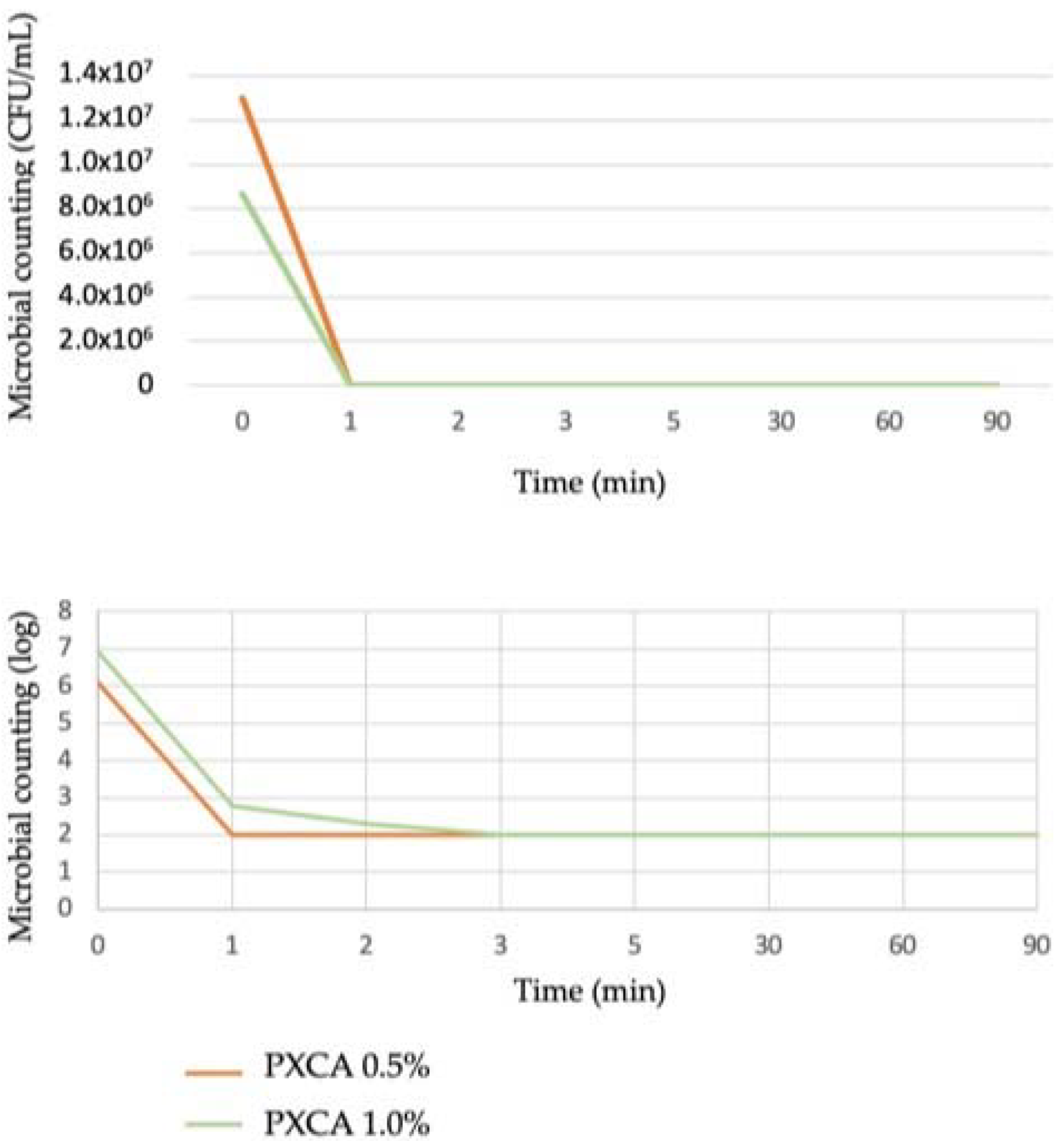
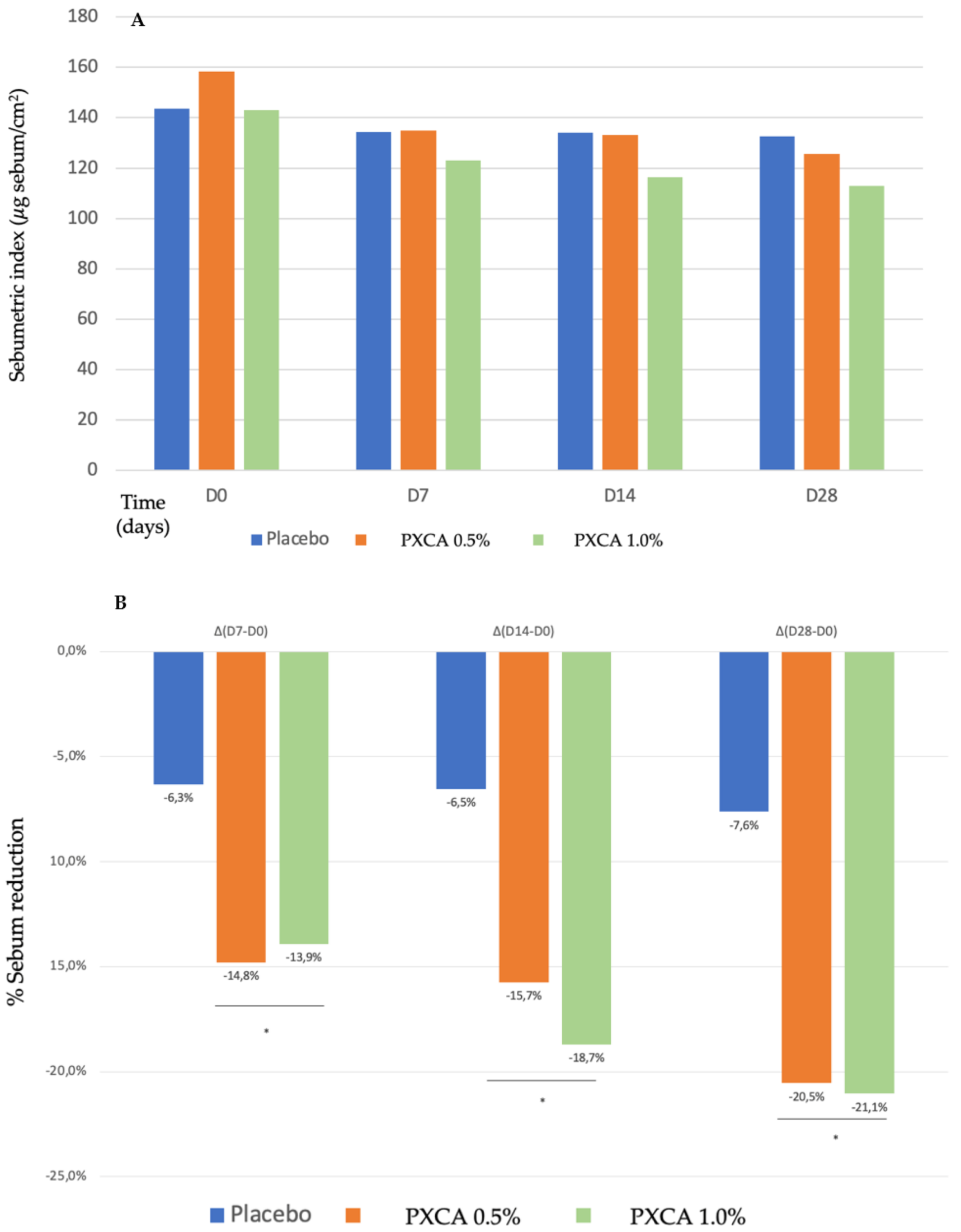
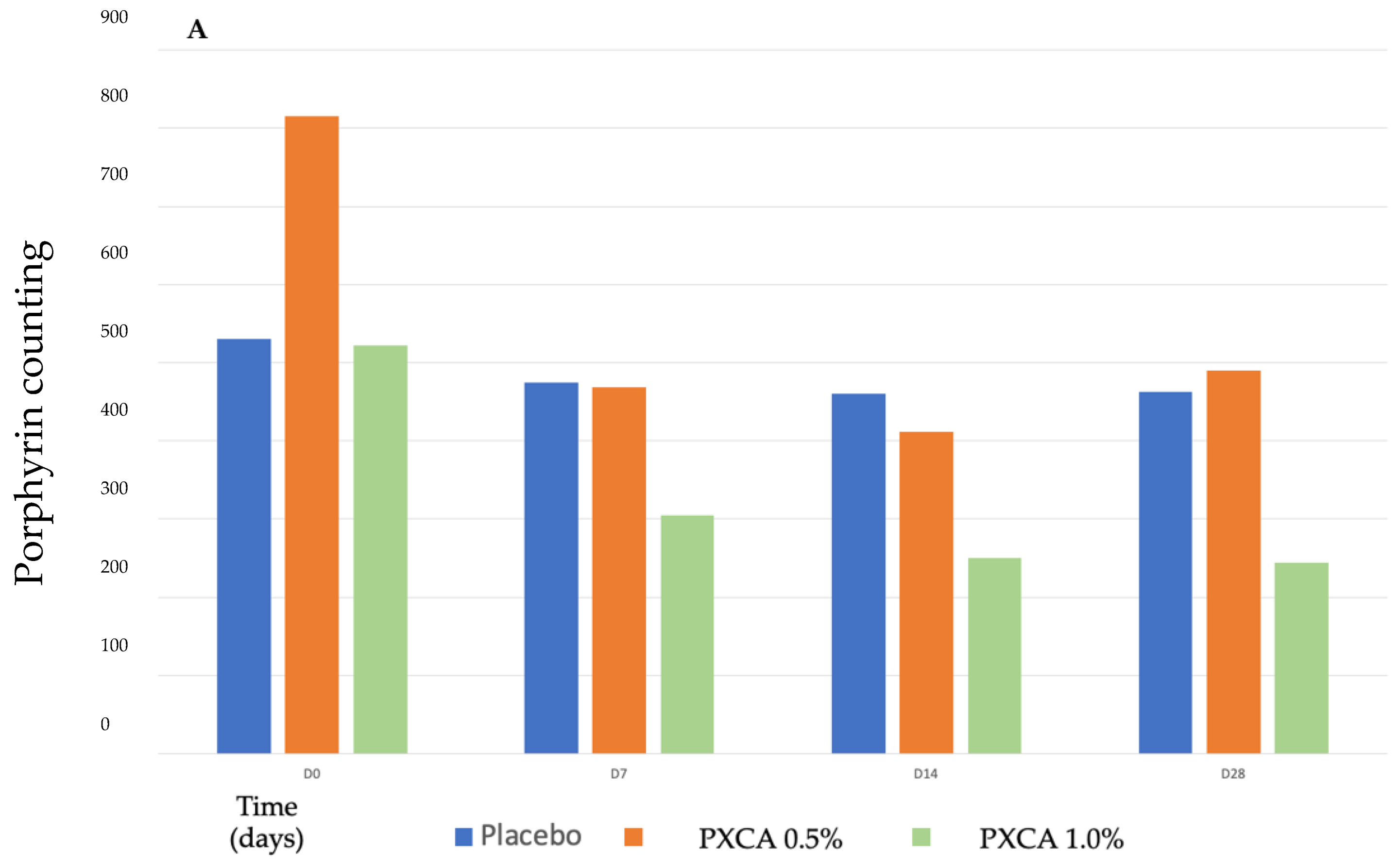
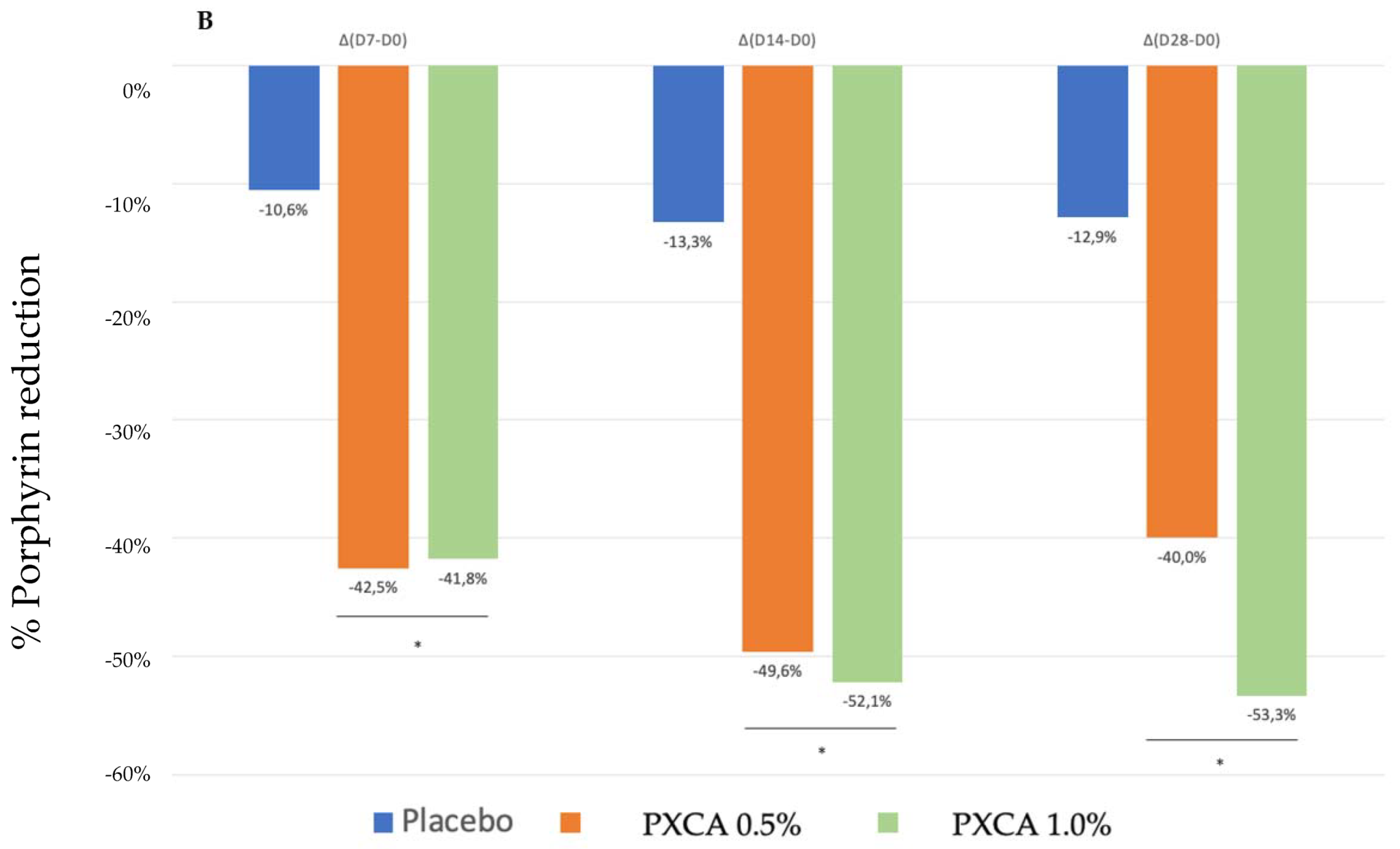
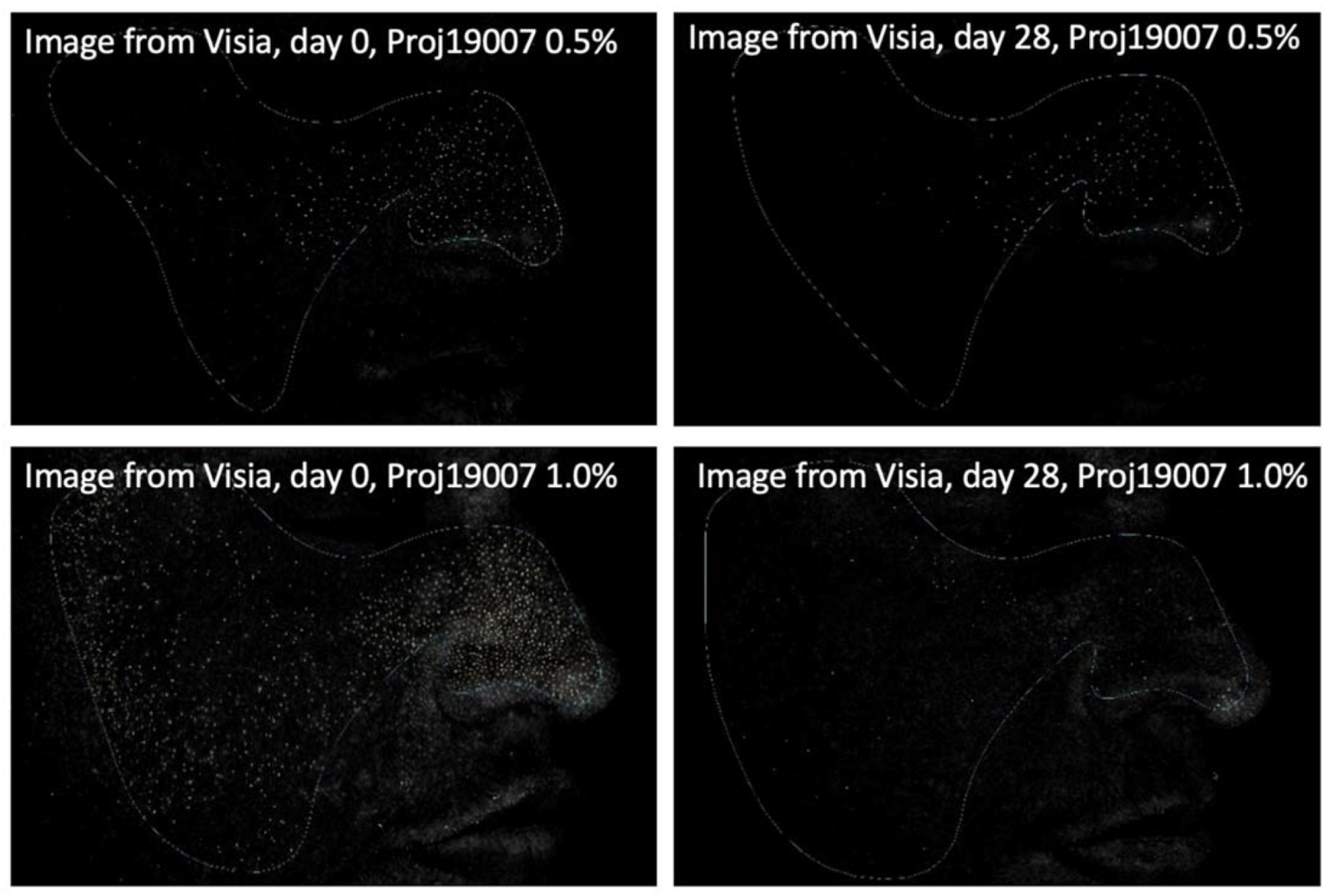
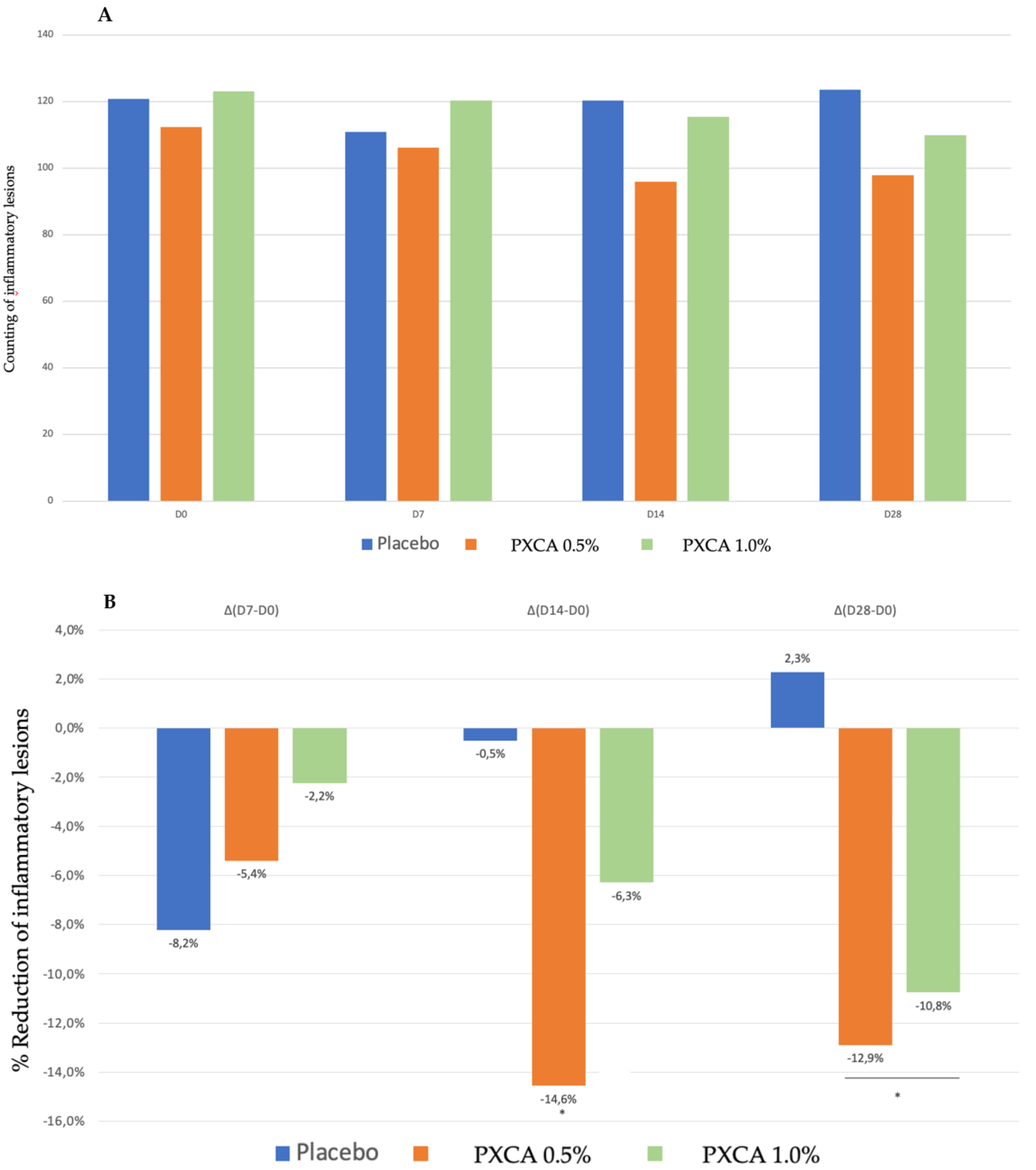
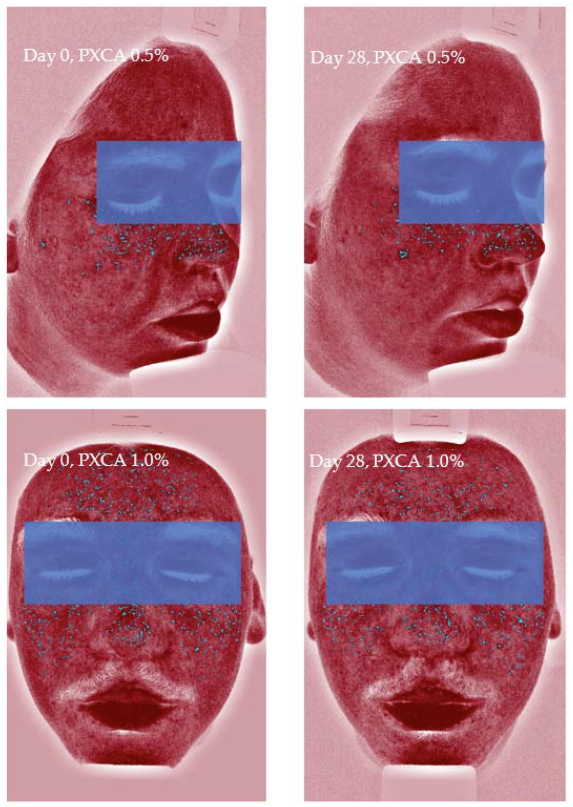

| Ingredients | % (w/w) | ||
|---|---|---|---|
| Placebo (Blank Sample) | PXCA 19007 0.5% | PXCA 19007 1.0% | |
| Cetearyl Alcohol (and) Polysorbate 60 (Uniox® C) (Chemyunion, Sorocaba, Brazil) | 12.00 | 12.00 | 12.00 |
| Aqua | 87.40 | 86.90 | 86.40 |
| Propanediol (and) Caprylic Acid (and) Xylitol (PXCA) (Chemyunion, Sorocaba, Brazil) | - | 0.50 | 1.00 |
| Phenoxyethanol (Merck, São Paulo, Brazil) | 0.35 | 0.35 | 0.35 |
| Potassium Sorbate (Merck, São Paulo, Brazil) | 0.25 | 0.25 | 0.25 |
Publisher’s Note: MDPI stays neutral with regard to jurisdictional claims in published maps and institutional affiliations. |
© 2021 by the authors. Licensee MDPI, Basel, Switzerland. This article is an open access article distributed under the terms and conditions of the Creative Commons Attribution (CC BY) license (https://creativecommons.org/licenses/by/4.0/).
Share and Cite
Mussi, L.; Baby, A.R.; Camargo Junior, F.B.; Padovani, G.; Sufi, B.d.S.; Magalhães, W.V. Propanediol (and) Caprylic Acid (and) Xylitol as a New Single Topical Active Ingredient against Acne: In Vitro and In Vivo Efficacy Assays. Molecules 2021, 26, 6704. https://doi.org/10.3390/molecules26216704
Mussi L, Baby AR, Camargo Junior FB, Padovani G, Sufi BdS, Magalhães WV. Propanediol (and) Caprylic Acid (and) Xylitol as a New Single Topical Active Ingredient against Acne: In Vitro and In Vivo Efficacy Assays. Molecules. 2021; 26(21):6704. https://doi.org/10.3390/molecules26216704
Chicago/Turabian StyleMussi, Lilian, André Rolim Baby, Flavio Bueno Camargo Junior, Giovana Padovani, Bianca da Silva Sufi, and Wagner Vidal Magalhães. 2021. "Propanediol (and) Caprylic Acid (and) Xylitol as a New Single Topical Active Ingredient against Acne: In Vitro and In Vivo Efficacy Assays" Molecules 26, no. 21: 6704. https://doi.org/10.3390/molecules26216704
APA StyleMussi, L., Baby, A. R., Camargo Junior, F. B., Padovani, G., Sufi, B. d. S., & Magalhães, W. V. (2021). Propanediol (and) Caprylic Acid (and) Xylitol as a New Single Topical Active Ingredient against Acne: In Vitro and In Vivo Efficacy Assays. Molecules, 26(21), 6704. https://doi.org/10.3390/molecules26216704







